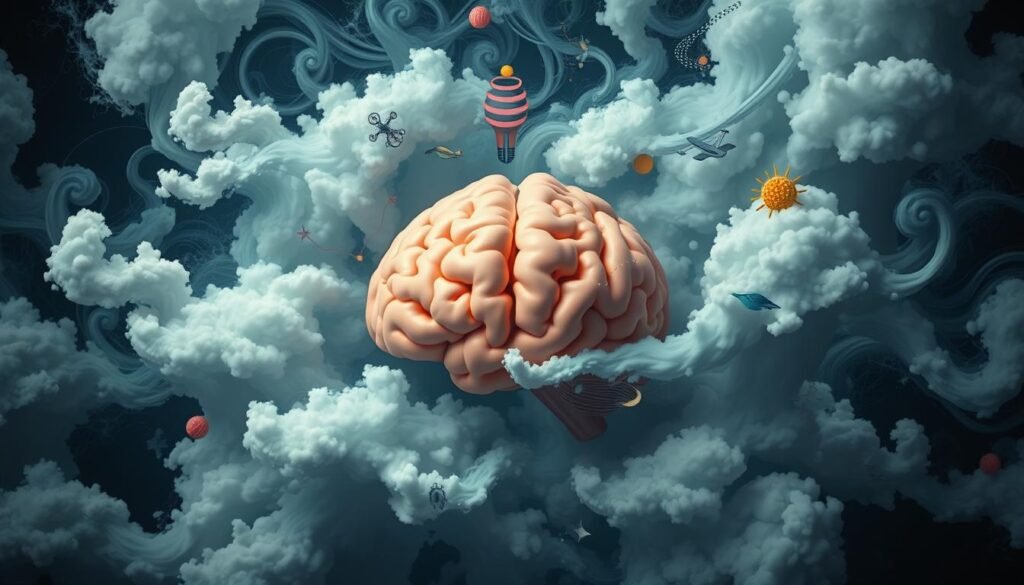More than 300 million people globally battle anxiety disorders. This fact highlights the pressing need for effective treatments. Gabapentin, used mainly for seizures and nerve pain, is now also used for anxiety. It shows promise, but it’s vital to know about its side effects. Gabapentin isn’t FDA-approved for anxiety treatment. Yet, understanding the side effects of gabapentin can lead to better treatment choices for those struggling with anxiety symptoms.
Key Takeaways
- Gabapentin is primarily used for seizures and nerve pain but is commonly prescribed off-label for anxiety.
- It is vital to be aware of both common and rare side effects associated with gabapentin.
- The prevalence of anxiety disorders underscores the need for effective treatment options like gabapentin.
- Patients should carefully consider their medical history and other medications before starting treatment with gabapentin.
- Monitoring for side effects is crucial when using gabapentin for managing anxiety symptoms.
Understanding Anxiety Disorders
Anxiety disorders impact many people around the world. In fact, over 300 million people suffer from them. These disorders can make daily activities, maintaining relationships, and feeling good about oneself hard. People with these issues might feel a lot of worry, fear, and nervousness.
There are different types of anxiety disorders, including:
- Generalized Anxiety Disorder (GAD): This means having constant and overwhelming worry.
- Social Anxiety Disorder: This involves a deep fear of being around others.
- Panic Disorder: This is having sudden, intense panic attacks.
- Specific Phobias: This is being very afraid of certain things or situations.
- Obsessive-Compulsive Disorder (OCD): This disorder makes someone have repeating thoughts or actions.
- Post-Traumatic Stress Disorder (PTSD): This can happen after seeing or going through something really scary.
It’s important to know about anxiety disorders, especially for those looking for ways to get better. Luckily, there are treatments that help a lot, like talking to a therapist or taking medicine. Cognitive-behavioral therapy (CBT) is one type of therapy that is especially helpful. Starting treatment early can improve lives significantly.
| Type of Anxiety Disorder | Prevalence |
|---|---|
| Generalized Anxiety Disorder | 3.1% of U.S. adults |
| Panic Disorder | 2-3% of people |
| Social Anxiety Disorder | 7% of the U.S. population |
| OCD | 1-2% of the population |
| Agoraphobia | 1.7% of people |
| PTSD | 3.6% of the adult population |
What is Gabapentin?
Gabapentin is a medication meant for seizures and neuropathic pain. Lately, it’s been used for anxiety too. However, it’s not officially approved for that. Its use in anxiety comes from studies showing it might help some people feel better.
Gabapentin works by imitating GABA, a brain chemical. This action helps calm nerve activity. This calming effect could help those with anxiety. Yet, gabapentin takes weeks to show its anxiety-reducing effects fully.
Starting doses of gabapentin at 300 mg several times daily can improve anxiety. People could see less anxiety with doses of 900 mg/day or more. But, lower doses might not be as effective.
Gabapentin comes in tablets, capsules, and liquids. This variety lets doctors adjust doses for each person’s needs. Knowing how gabapentin works can help people manage anxiety better.
Gabapentin Anxiety Treatment
Gabapentin is sometimes used for anxiety, even though it’s not its main use. It can help people who don’t get better with common medicines. Some studies show it works well for social anxiety and panic attacks. But, how well it works can be different for each person.
The starting dose of gabapentin is usually 300 mg at night. Doctors often tell patients to slowly take more, following their advice. The most you can take in a day is 3,600 mg, says the FDA. But for mood and to help with depression, 900 to 2,000 mg is common.
Using gabapentin with therapy like CBT works even better. This combo can make treatment 60% more successful than using just one. Some people feel better in the first week. Others might need a few weeks to see if it helps.
| Dosage | Purpose | Typical Response Time |
|---|---|---|
| 300 mg | Initial treatment for anxiety | First week |
| 900 – 2,000 mg | Mood stabilization or antidepressant support | Several weeks |
| Up to 3,600 mg | Maximum FDA-approved dose | Varies |
In the U.S., less than one percent of gabapentin’s prescriptions between 2011 and 2016 were for approved uses. By 2020, it became the sixth most prescribed drug. This shows how often it’s chosen for anxiety treatment, even though that’s not what it’s primarily for.
Does Gabapentin Help with Anxiety?
Gabapentin is being used more for anxiety, even though it’s not its main use. Studies show it might help some people. It could be especially useful for those who don’t do well with usual antidepressants.
Research suggests gabapentin could lower anxiety. This was seen in cases where standard treatments didn’t work. For instance, a person noticed big improvements with gabapentin. They started on a small dose of 300 mg. Some need up to 3,600 mg a day.
Gabapentin can be useful for various anxiety disorders. It can work well with other treatments, like SSRIs or therapy. Cognitive Behavioral Therapy (CBT) combined with gabapentin can really help.
Remember, gabapentin isn’t approved for anxiety by the FDA. It’s mainly for nerve pain and seizures. But, its soothing effects can help some with anxiety. More study on gabapentin for anxiety is needed.

How Gabapentin Works in the Brain
Gabapentin was first made to treat seizures and nerve pain. It acts like the neurotransmitter GABA in the brain. This is important because it helps control how active our nerves are.
By doing this, it can help people who feel too anxious. It’s important to note that the FDA hasn’t officially approved gabapentin for treating anxiety. However, it’s being used more and more for this purpose.
Gabapentin works by changing how our bodies send messages between nerves. This reduces the overactivity in our brains. This is especially helpful for those with anxiety disorders.
Research shows gabapentin could be a big help for people with social anxiety and panic attacks. It’s good news for those looking for help in these areas.
Improvements in how we feel can be seen in about three weeks with gabapentin. Yet, doctors often suggest options like SSRIs and SNRIs for anxiety. These are known to be safe and work well.
Doctors still think about gabapentin for anxiety, especially if nothing else works. Understanding how it works in the brain sheds light on its use for managing anxiety in some people.
Looking for more about gabapentin’s impact on anxiety? You can find more information here.
Side Effects of Gabapentin for Anxiety
It’s important to know the side effects of gabapentin for anxiety. This medication treats nerve pain and seizures but is now widely used for anxiety, too. Knowing the possible side effects is key.
Common Side Effects
Users of gabapentin might face common and serious gabapentin side effects. They range from mild to moderate. Some are:
- Drowsiness
- Dizziness
- Nausea and vomiting
- Fatigue
- Mood changes
- Weight gain
After starting gabapentin, it often takes weeks to see anxiety symptoms improve. Watching these side effects is crucial for the medicine to work well without too much trouble.
Rare but Serious Side Effects
There are also rare but severe side effects of gabapentin. They need quick medical help. Some include:
- Thoughts of self-harm
- Jaundice (yellowing of the skin and eyes)
- Severe allergic reactions, such as anaphylaxis
- Unusual changes in behavior, including increased aggression or depression
Patients should talk about any worrisome symptoms with doctors. Combining gabapentin with other medications can be harmful. For more info, see this resource.

Gabapentin Dosage for Anxiety
Finding the right gabapentin amount for anxiety is key. The gabapentin dosage anxiety needed can change from person to person. It depends on how severe the anxiety is and the person’s health. Usually, people take between 300 mg and 3,600 mg a day. A doctor will adjust this to get the best results.
Generally, treatment starts at 300 mg daily. Depending on what the person needs, this can be increased slowly. It’s often split into three doses for easier handling. Studies show that benefits might begin within the first four weeks. And improvements can keep coming for more than eight weeks.
It’s important to listen to your doctor’s advice carefully. They might change the dose based on how you react or how well the medication works. Some may feel dizzy, sleepy, or tired, which needs to be watched. For more details, check out this link.
Gabapentin Off-Label Use for Anxiety
Gabapentin is now widely used for off-label use for anxiety. This means doctors prescribe it for anxiety disorders even though the FDA hasn’t officially approved it for this use. This practice is growing as doctors see good results in patients. People with generalized anxiety disorder and other anxiety types feel better with Gabapentin.
Studies show Gabapentin eases anxiety symptoms in certain groups. It helps breast cancer survivors, people with social phobia, and those with panic disorder. There’s a case where a patient with hard-to-treat generalized anxiety disorder improved using Gabapentin. This suggests it might help with a wide range of anxiety conditions.
Doctors think Gabapentin helps anxiety because it calms the nervous system. They look at the benefits but also think about the ethics and rules of prescribing it this way. Although evidence on Gabapentin for generalized anxiety disorder is not clear, many doctors believe in its usefulness for anxiety symptoms.
About 20% of adults face anxiety disorders each year. Understanding this is key to seeing how Gabapentin can be part of treatment. More women struggle with anxiety, raising the need for effective treatments. So, doctors often use medicines like Gabapentin, initially for epilepsy or pain, to help those with anxiety.
| Condition | Observed Benefits of Gabapentin |
|---|---|
| Generalized Anxiety Disorder | Reduction in irritability and improvement in overall anxiety symptoms |
| Social Anxiety Disorder | Decreased fear of social situations and enhanced comfort |
| Panic Disorder | Lower incidence of panic attacks and anxiety-related avoidance behaviors |
| Post-Traumatic Stress Disorder | Alleviation of intrusive thoughts and improvement in sleep quality |
Gabapentin’s off-label use for anxiety is an important area for mental health treatment. It fills gaps left by traditional anxiety therapies.
Gabapentin Interactions with Other Medications
Gabapentin is often given to people who have anxiety. But, it can interact with other medications in significant ways. Knowing about these interactions is key for safe use. Some drugs, like opioids, benzodiazepines, and alcohol, can cause bigger problems like harder breathing and too much sleepiness if used with gabapentin.
Here’s a list of some common drugs that can have issues with gabapentin:
| Medication | Type | Potential Interaction |
|---|---|---|
| Opioids | Pain Relief | Increased risk of respiratory depression |
| Benzodiazepines | Anti-Anxiety/Sleep Aid | Enhanced sedative effects |
| Alcohol | CNS Depressant | Worsened drowsiness and dizziness |
| Cannabis | CNS Depressant | Increased drowsiness and focus issues |
| Phenytoin | Anticonvulsant | Altered therapeutic effects |
| Losartan | Antihypertensive | Potential changes in blood pressure control |
Individuals must tell their doctors about any health issues they have. For example, problems like diabetes, kidney, or breathing issues. This information helps make sure gabapentin is safe and works well. Pregnant people should be extra careful. The effect of gabapentin on pregnant women isn’t fully understood. Those who are breastfeeding should talk to their doctors too. Gabapentin can get into breast milk.
It’s very important for people using gabapentin to tell all their healthcare providers about any other medicines they are on. This includes prescriptions, over-the-counter medicines, and any supplements. Being careful helps avoid bad reactions with gabapentin. It ensures the treatment for anxiety is as effective as possible.
Gabapentin Alternatives for Anxiety Relief
There are many ways to treat anxiety. For those seeking alternatives to gabapentin, options are varied. Common choices include medications like pregabalin (Lyrica), amitriptyline (Elavil), and duloxetine (Cymbalta). Each option has its own set of benefits and possible side effects.
Pregabalin works on nerve pain and anxiety. Yet, it may cause tiredness, dizziness, and a dry mouth. Amitriptyline is also good for nerve pain. But it might lead to nausea and constipation, offering a solution for those wary of gabapentin’s side effects.
Duloxetine helps with both nerve pain and anxiety. However, it can cause heartburn and make you urinate more. For those preferring non-drug options, techniques like cognitive-behavioral therapy work well. Natural remedies, such as cayenne and Vitamin B12, can also help.
Here’s a table showing some gabapentin alternatives and their side effects:
| Medication | Uses | Common Side Effects |
|---|---|---|
| Pregabalin (Lyrica) | Anxiety, nerve pain | Tiredness, dizziness, dry mouth |
| Amitriptyline (Elavil) | Neuropathic pain | Nausea, constipation, dry mouth |
| Duloxetine (Cymbalta) | Nerve pain, anxiety | Heartburn, increased urination |
| Clonazepam (Klonopin) | Panic attacks, seizures | Dizziness, increased saliva, mood changes |
| Natural Alternatives | Pain relief | Cayenne, Vitamin B12 |

Talk to your doctor before switching medications. They can guide you on withdrawal symptoms and find the right treatment for you. Exploring different options can give you a new outlook on handling anxiety.
Gabapentin Withdrawal Symptoms
Stopping gabapentin can cause many hard withdrawal symptoms. These usually start 12 to 48 hours after you stop taking it. You might feel a lot more anxious, which makes quitting tough. Learn more about gabapentin withdrawal anxiety.
Common withdrawal symptoms include:
- Insomnia and sleep problems
- Nausea and throwing up
- Headaches or migraines
- Feeling irritable or agitated
- Flu-like symptoms, like body aches and chills
Severe symptoms like seizures and seeing things that aren’t there can happen too. These symptoms usually get worst between 2 to 7 days after stopping. People who took high doses for at least three weeks face stronger symptoms. Withdrawal can feel a lot like stopping alcohol or benzodiazepines because of the way they affect the brain.
It’s super important to talk with a doctor if you want to stop gabapentin. They can help you slowly reduce the dose to ease withdrawal symptoms. A good plan might be to cut down 300mg from your daily dose every four days. Joining a detox program might help with the psychological side of gabapentin addiction.
Sometimes, withdrawal symptoms can last a long time, leading to post-acute withdrawal syndrome (PAWS). This can go on for weeks or months. Even after the worst is over, you might still feel anxious or depressed for a while. Focusing on your mental and physical health is key to getting better.
| Withdrawal Symptom | Onset Time | Peak Duration |
|---|---|---|
| Increased Anxiety | 12-48 hours | 2-7 days |
| Insomnia | 12-48 hours | 7-10 days |
| Nausea/Vomiting | 12-48 hours | up to 10 days |
| Seizures | within 24 hours | Varies |
| Post-Acute Withdrawal Syndrome (PAWS) | after 1 week | weeks to months |
If you’re thinking about stopping gabapentin, understanding what to expect is crucial. Customizing your cessation plan with medical help and perhaps other treatments increases your chance of a smooth recovery.
Conclusion
Gabapentin is becoming popular in treating anxiety. This includes generalized anxiety disorder and social anxiety disorder. Even though it’s not FDA-approved for anxiety, more doctors are using it. They are looking beyond traditional SSRIs and benzodiazepines. The way gabapentin works to ease anxiety looks promising. Yet, we need more research to fully understand it.
Some people find gabapentin really helps with anxiety, according to studies. But, results vary so it’s important to be careful. If taking gabapentin, you must work closely with your doctor. Watch out for possible side effects like feeling dizzy or sleepy. Making sure the dose is right and checking on mood changes are key steps.
Choosing the right anxiety treatment should be a team effort. If you’re dealing with anxiety, talk to your healthcare provider about gabapentin and other options. It’s important to weigh the pros against any cons under expert advice. Doing so can help manage anxiety better. It can lead to a happier and healthier life.